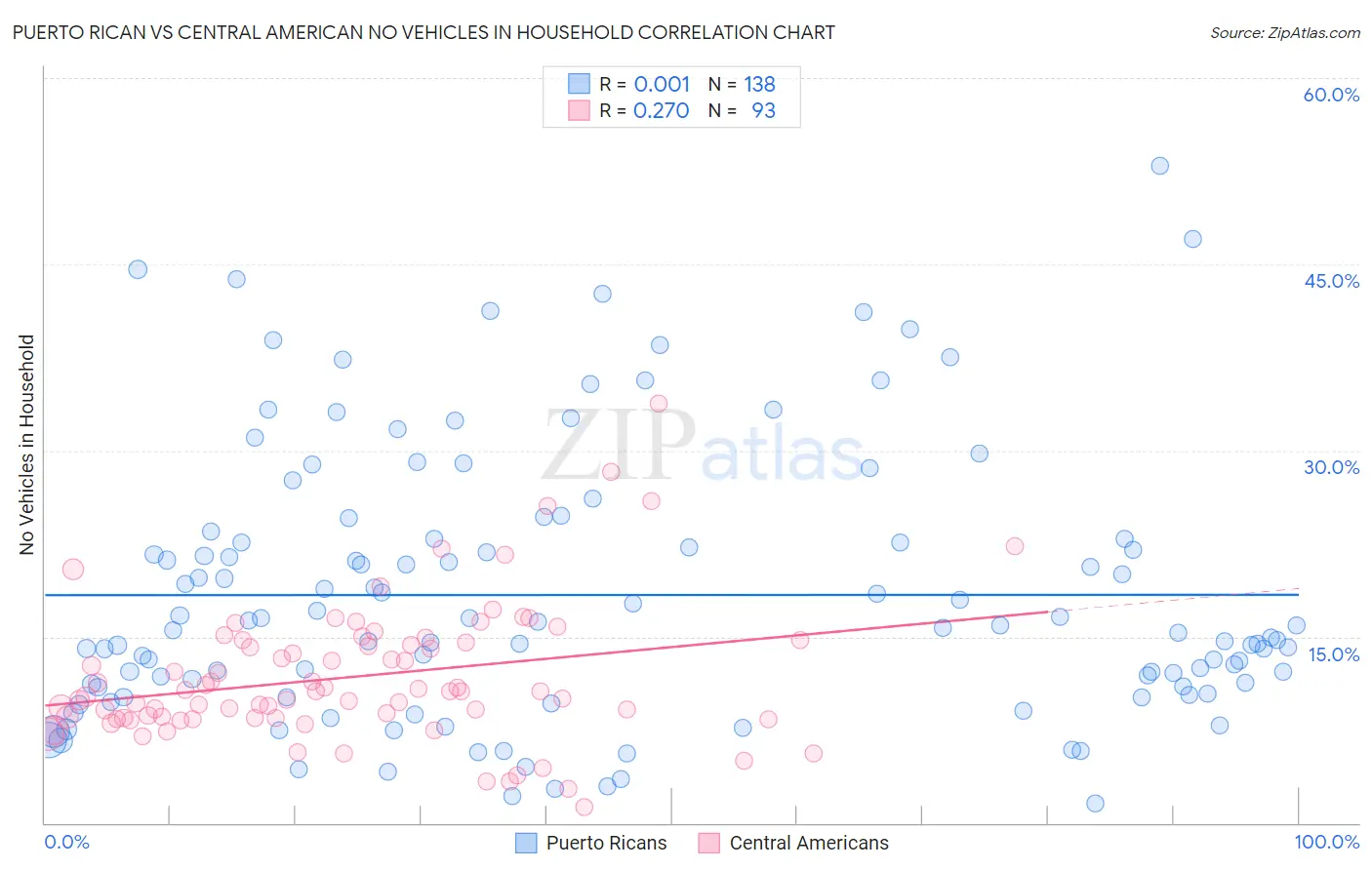Puerto Rican vs Central American No Vehicles in Household
COMPARE
Puerto Rican
Central American
No Vehicles in Household
No Vehicles in Household Comparison
Puerto Ricans
Central Americans
15.5%
NO VEHICLES IN HOUSEHOLD
0.0/ 100
METRIC RATING
309th/ 347
METRIC RANK
10.8%
NO VEHICLES IN HOUSEHOLD
24.3/ 100
METRIC RATING
196th/ 347
METRIC RANK
Puerto Rican vs Central American No Vehicles in Household Correlation Chart
The statistical analysis conducted on geographies consisting of 525,427,776 people shows no correlation between the proportion of Puerto Ricans and percentage of households with no vehicle available in the United States with a correlation coefficient (R) of 0.001 and weighted average of 15.5%. Similarly, the statistical analysis conducted on geographies consisting of 502,389,156 people shows a weak positive correlation between the proportion of Central Americans and percentage of households with no vehicle available in the United States with a correlation coefficient (R) of 0.270 and weighted average of 10.8%, a difference of 43.3%.

No Vehicles in Household Correlation Summary
| Measurement | Puerto Rican | Central American |
| Minimum | 1.5% | 1.3% |
| Maximum | 53.0% | 33.8% |
| Range | 51.4% | 32.6% |
| Mean | 18.4% | 11.8% |
| Median | 15.6% | 10.6% |
| Interquartile 25% (IQ1) | 10.9% | 8.4% |
| Interquartile 75% (IQ3) | 22.8% | 14.7% |
| Interquartile Range (IQR) | 11.9% | 6.2% |
| Standard Deviation (Sample) | 10.8% | 5.5% |
| Standard Deviation (Population) | 10.8% | 5.5% |
Similar Demographics by No Vehicles in Household
Demographics Similar to Puerto Ricans by No Vehicles in Household
In terms of no vehicles in household, the demographic groups most similar to Puerto Ricans are Cape Verdean (15.6%, a difference of 0.56%), Immigrants from Israel (15.6%, a difference of 0.57%), U.S. Virgin Islander (15.4%, a difference of 0.65%), Immigrants from Haiti (15.4%, a difference of 0.69%), and Alaskan Athabascan (15.6%, a difference of 0.72%).
| Demographics | Rating | Rank | No Vehicles in Household |
| Haitians | 0.0 /100 | #302 | Tragic 14.9% |
| Immigrants | Western Africa | 0.0 /100 | #303 | Tragic 15.0% |
| Immigrants | Russia | 0.0 /100 | #304 | Tragic 15.1% |
| Immigrants | China | 0.0 /100 | #305 | Tragic 15.2% |
| Immigrants | Belize | 0.0 /100 | #306 | Tragic 15.4% |
| Immigrants | Haiti | 0.0 /100 | #307 | Tragic 15.4% |
| U.S. Virgin Islanders | 0.0 /100 | #308 | Tragic 15.4% |
| Puerto Ricans | 0.0 /100 | #309 | Tragic 15.5% |
| Cape Verdeans | 0.0 /100 | #310 | Tragic 15.6% |
| Immigrants | Israel | 0.0 /100 | #311 | Tragic 15.6% |
| Alaskan Athabascans | 0.0 /100 | #312 | Tragic 15.6% |
| Tohono O'odham | 0.0 /100 | #313 | Tragic 15.6% |
| Albanians | 0.0 /100 | #314 | Tragic 15.6% |
| Cypriots | 0.0 /100 | #315 | Tragic 15.7% |
| Ghanaians | 0.0 /100 | #316 | Tragic 16.4% |
Demographics Similar to Central Americans by No Vehicles in Household
In terms of no vehicles in household, the demographic groups most similar to Central Americans are Shoshone (10.8%, a difference of 0.040%), Immigrants from Sweden (10.8%, a difference of 0.25%), Immigrants from Brazil (10.8%, a difference of 0.34%), Pueblo (10.8%, a difference of 0.45%), and Immigrants from Asia (10.9%, a difference of 0.56%).
| Demographics | Rating | Rank | No Vehicles in Household |
| Immigrants | Eritrea | 36.3 /100 | #189 | Fair 10.6% |
| Immigrants | North Macedonia | 34.6 /100 | #190 | Fair 10.6% |
| Immigrants | Northern Europe | 33.1 /100 | #191 | Fair 10.7% |
| Carpatho Rusyns | 32.1 /100 | #192 | Fair 10.7% |
| Ukrainians | 28.0 /100 | #193 | Fair 10.7% |
| Pueblo | 27.0 /100 | #194 | Fair 10.8% |
| Immigrants | Brazil | 26.3 /100 | #195 | Fair 10.8% |
| Central Americans | 24.3 /100 | #196 | Fair 10.8% |
| Shoshone | 24.1 /100 | #197 | Fair 10.8% |
| Immigrants | Sweden | 22.9 /100 | #198 | Fair 10.8% |
| Immigrants | Asia | 21.3 /100 | #199 | Fair 10.9% |
| Cambodians | 19.6 /100 | #200 | Poor 10.9% |
| Immigrants | Western Europe | 19.1 /100 | #201 | Poor 10.9% |
| Romanians | 17.9 /100 | #202 | Poor 10.9% |
| Iroquois | 17.6 /100 | #203 | Poor 10.9% |